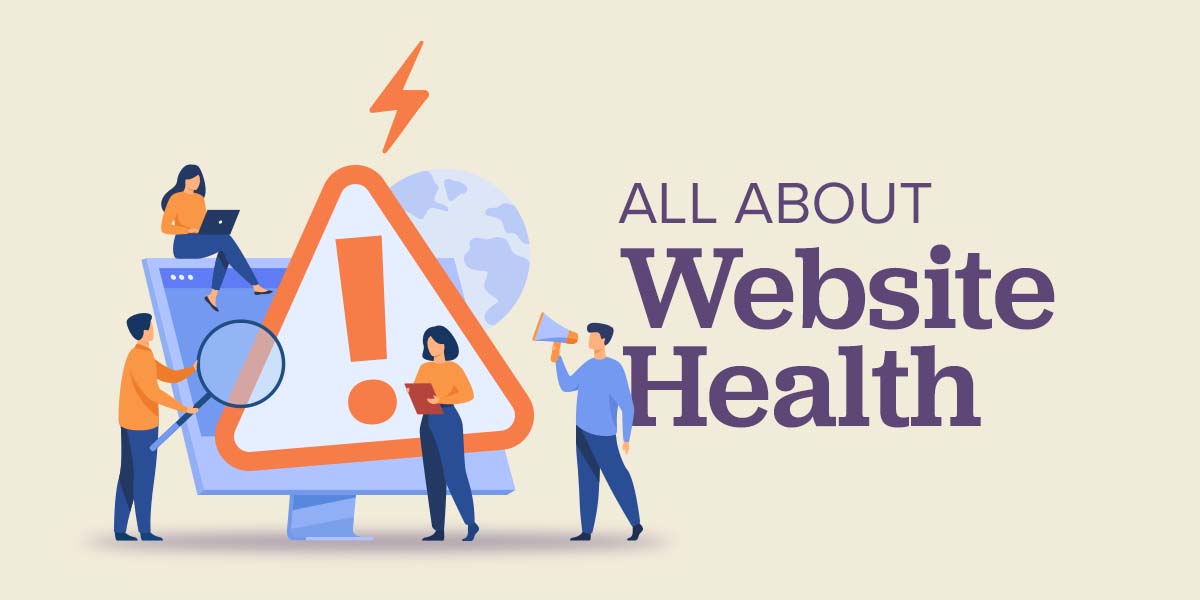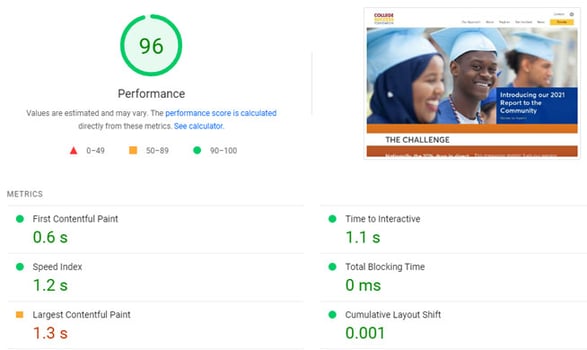
As a nonprofit organization, poor website health could actually be affecting your business. The foundation of your digital presence is, without a doubt, a high-performing website. But, it can be easy to let other priorities overshadow website health, especially if it isn’t your area of expertise.
Website health influences digital success. Healthy websites ensure long-term success, higher reach, and more engagement. For nonprofits, this is essential for community engagement and giving. Healthy sites are also optimized for all users and don’t have any issues that could affect the user experience. On the other hand, poor website health can lead to a loss in traffic and search results rankings.
Website health is also important when it comes to search engine optimization (SEO). Sites with faster load times and fewer issues will rank higher in search.
Often, your website is the first interaction people have with your brand. If you can't convince users to stay on your pages, you’re leaving money on the table.
How to improve website health
Speed up your site pages
Page speed is a measurement of how fast the content on your page loads.
In our age of instant gratification, visitors won’t wait around for a slow site to load. The average user spends less than 15 seconds on a website. If your pages don’t load right away, you’ll leave a bad first impression. Pages with longer load times tend to have higher bounce rates and lower average time on page. Ideally, pages should load in two to three seconds.

To check page load times, use Google PageSpeed Insights (PSI). PSI scores sites as either Good, Needs Improvement, or Poor. It also provides recommendations on how to improve load time on both desktop and mobile devices. PSI uses Lighthouse to analyze the URL and generate a performance score.
Fix 404 errors and reduce redirects
Broken links are those that display a “404 Page Not Found” error message. Error pages can affect the crawling of your website, which will affect your search rankings. They’ll also cause visitors to spend less time on your website. This tells search engines that you aren’t providing a good user experience, and will hurt your search rankings.
Two tools that will spot 404 error pages are Semrush and Screaming Frog. For both, after plugging in the domain, the tool will run a scan on your website. Since both tools spot more than 404 errors, you’ll need to navigate to the 404 report to view the list of error pages. You can use this list to find pages that need to be redirected to live pages on your website.
But, once you’ve redirected the error pages, make sure that users aren’t redirected too many times. Each time a page redirects, users spend more time waiting for the HTTP request-response cycle to complete. The fewer redirects, the faster the page speed.
Decrease image file sizes
Image files are large and take up a lot of space. Large files can slow down your site and take a long time to load. To improve website health, decrease file sizes and compress all images. Because most users browse the web via mobile device, there is no need for huge files. In fact, you shouldn't need images larger than 1000px wide. Many websites use even smaller image sizes.

Optimize for mobile
Google has confirmed that mobile speed contributes to the ranking algorithm. Ideally, your website should work well on all devices. Having to adjust the screen will cause visitors to leave and go to a website with a better user experience. With more than half of all visitors arriving via mobile devices, this is a problem.
Test to see if your website works on mobile phones and tablets with different screen sizes. Use Google’s Mobile Speed Tool to test how your website responds on mobile devices and make sure your mobile pages are performing well.
Create grammar-free, relevant content
Content plays a major part in all marketing efforts, so there’s no surprise that it also factors into website health. Because search rankings, engagement, and conversions rely on content quality, great content is the key to success.
If content quality drops, this can lead to higher bounce rates and shorter retention. Long gone are the days when all you had to do was write a short 200-word article. For consistent results, write high-quality posts in the range of 1000 to 1500+ words.
Updated blogs perform better in search results than outdated posts. The more often you publish a new or updated post, the quicker search engines will crawl and index your site. Try to maintain a manageable posting schedule whether that's a few times per week or month.
Optimize for search
Search engine optimization (SEO) refers to optimizing your site to rank higher on search engines. This is one of the most important pieces to having a healthy website. Good SEO sends visitors to your website without costing any money.
Here are a few things you can implement right away to optimize for search engines:
- Place contact information, including phone number and address, in the footer.
- Have a link to your address with Google Maps on your contact page.
- Perform keyword research and optimize pages with on-page SEO targeting those keywords.
- Create a sitemap to allow search engines to index your website.

How to monitor your website health
There are several ways to monitor website health, with both free and paid tools available. As always, consider your particular needs as a starting point.
Check for red flags
Issues with your website can impact your business more than you realize. These issues present themselves as warnings, but you need to know what to look for. Google Analytics can give insight to website issues. Check for metrics such as high bounce rate, low time on page, or low pages per session. These are signs that your website either has technical issues or a poor user experience.
Perform regular website health check-ins
A website that provides an exceptional user experience drives quality leads and conversions. Google offers free tools such as PageSpeed Insights, Mobile-Friendly Test and Search Console to check for issues.
Websites aren’t marketing tools that you can design, launch, and never look at again. To have a healthy website you need to maintain it. If you need assistance improving your website health, contact ArcStone.